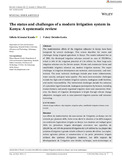| dc.contributor.author | Kanda, Edwin Kimutai | |
| dc.contributor.author | Lutta, Valery Osimbo | |
| dc.date.accessioned | 2022-09-19T12:02:06Z | |
| dc.date.available | 2022-09-19T12:02:06Z | |
| dc.date.issued | 2022-03-14 | |
| dc.identifier.uri | https://doi.org/10.1002/ird.2700 | |
| dc.identifier.uri | https://onlinelibrary.wiley.com/doi/epdf/10.1002/ird.2700 | |
| dc.identifier.uri | http://ir-library.mmust.ac.ke:8080/xmlui/handle/123456789/2096 | |
| dc.description.abstract | The modernization efforts of the irrigation subsector in Kenya have been hampered by several challenges. This review describes the status and challenges facing irrigated agriculture in Kenya. The results indicated that as of 2018, the developed irrigation schemes covered an area of 222,240 ha, which is 16% of the irrigation potential of 1.34 million ha. Most large-scale irrigation schemes use the furrow system. Private and commercial farms and smallholder irrigation schemes use modern irrigation systems. The major challenges to irrigation development are technical, socio-economic, and institutional. The main technical challenges include poor water infrastructure, water scarcity, and poor water quality. The main socio-economic challenges include the high cost of modern irrigation systems, inadequate credit facilities, and market inaccessibility. The institutional challenges include the existence of a pluralistic legal framework, inadequate participation by farmers, including women farmers, and poorly organized irrigation water user associations. However, the future of irrigation development is bright through climate change adaptation strategies such as solar-powered irrigation systems and rainwater harvesting. | en_US |
| dc.language.iso | en | en_US |
| dc.publisher | Irrigation and Drainage | en_US |
| dc.subject | Status, challenges , modern, irrigation, system, systematic, review | en_US |
| dc.title | The status and challenges of a modern irrigation system in Kenya: A systematic review | en_US |
| dc.type | Article | en_US |

